An insect of mass starts moving on a rough inclined surface from point . As the surface is very sticky, the coefficient of friction between the insect and the incline is . Assume that it can move in any direction, up the incline or down the incline. Then,
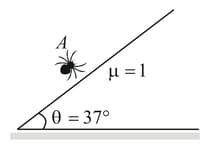

Important Questions on Newton's Laws of Motion II
A block of mass is placed on a wedge of an angle , as shown. The block is moving over the inclined surface of the wedge. The friction coefficient between the block and the wedge is , whereas it is between the wedge and the horizontal surface. If and , find the minimum value of , so that the wedge remains stationary on the surface.
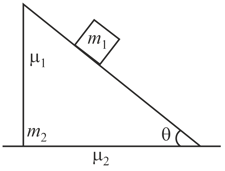
As shown in the figure, is a man of mass standing on a block of mass kept on the ground. The coefficient of friction between the feet of the man and the block is and that between and the ground is . If the man accelerates with an acceleration in the forward direction, then

The coefficient of friction between the block and the horizontal surface is . The block moves towards right under the action of horizontal force , as in the figure . Sometime later, another force is also applied to the block making an angle (such that ) with vertical, as shown in figure . After the application of force , the acceleration of block shall
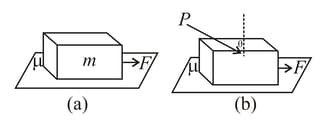
In the figure shown, if friction coefficient of blocks and with an inclined plane is and , respectively, then find the correct statement.
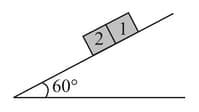
A force (where is time in ) is applied at to the block of mass placed on a rough horizontal surface. The coefficient of static and kinetic friction between the block and surface are and , respectively. Which of the following graphs best represent the acceleration vs time of the block ?

A block rests over another block placed over a smooth horizontal surface. There is friction between and . A horizontal force , gradually increasing from zero to a maximum, is applied to , so that the blocks move together without relative motion. Instead of this, another horizontal force , gradually increasing from zero to a maximum, is applied to , so that the blocks move together without relative motion. Then,
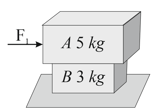
In the figure shown, the coefficient of static friction between and the wall is and the coefficient of kinetic friction between and the wall is . Other contacts are smooth. Find the minimum forcerequired to lift up. Now, if the force applied on is slightly increased than the calculated value of minimum force, then find the acceleration of . Mass of is and mass of is . Take .
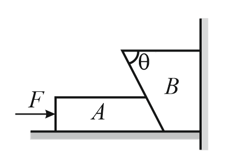
Two blocks of massand (in ) are connected by an inextensible light thread which passes over a light frictionless pulley. The whole system is placed over a fixed horizontal table as shown below. The coefficient of friction between the blocks and table surface is . The pulley is pulled by a string attached to its center and accelerated to the left with acceleration . Assume that gravity acts with constant acceleration downwards through the plane of the table.
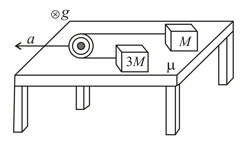
(a) Find the horizontal acceleration of both the blocks. (Assume that both the blocks are moving.)
(b) What is the maximum acceleration , for which the block of mass will remain stationary?
